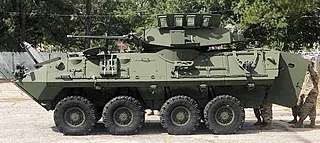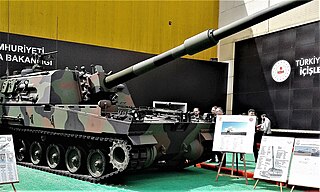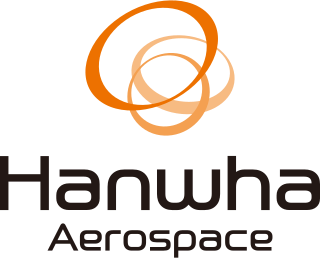
The M109 is an American 155 mm turreted self-propelled howitzer, first introduced in the early 1960s to replace the M44. It has been upgraded a number of times, most recently to the M109A7. The M109 family is the most common Western indirect-fire support weapon of maneuver brigades of armored and mechanized infantry divisions. It has a crew of four: the section chief/commander, the driver, the gunner, and the ammunition handler/loader.

The LAV-25 is a member of the LAV II family. It is an eight-wheeled amphibious armored reconnaissance vehicle built by General Dynamics Land Systems and used by the United States Marine Corps and the United States Army.

Hanwha Vision, founded as Samsung Techwin, is a video surveillance company. It is a subsidiary of Hanwha Group. The company employs 1,822 people and is headquartered in South Korea. Its total sales in 2020 were 529.8 billion South Korean won.

The K1, also known as Type 88 by American engineers, is a South Korean main battle tank designed by Chrysler Defense and Hyundai Precision Industry for the Republic of Korea Armed Forces. The vehicle's design was based on technology from Chrysler's M1 Abrams, tailored to meet the ROK's unique requirements. The K1A1 is an up-gunned variant with a 120 mm 44 caliber smoothbore gun, and outfitted with more modern electronics, ballistic computers, fire control systems, and armor. Hyundai Rotem produced 1,511 K1 and K1A1 tanks between 1986 and 2011.

The K9 Thunder is a South Korean 155 mm self-propelled howitzer designed and developed by the Agency for Defense Development and private corporations including Dongmyeong Heavy Industries, Kia Heavy Industry, Poongsan Corporation, and Samsung Aerospace Industries for the Republic of Korea Armed Forces, and is now manufactured by Hanwha Aerospace. K9 howitzers operate in groups with the K10 Ammunition Resupply Vehicle variant.

K2 Black Panther is a South Korean fourth-generation main battle tank (MBT), designed by the Agency for Defense Development and manufactured by Hyundai Rotem. The tank's design began in the 1990s to meet the strategic requirements of the Republic of Korea Army's reform for three-dimensional, high-speed maneuver warfare based on use of network-centric warfare.

The K200 KIFV is a South Korean armored personnel carrier, originally produced by Daewoo Heavy Industries as a domestic replacement for older armored personnel carriers, such as the M113, in front line service with the Republic of Korea Armed Forces at the time of the K200's development. Since 2009 the K200 has been supplemented by the K21. A total of 2,383 K200 vehicles of all configurations were produced between 1985 and 2006, among which are 111 K200A1 vehicles exported to Malaysia.

The K21 is a South Korean infantry fighting vehicle. A replacement for the K200-series, it was formerly designated as K300 or XK21 KNIFV. The initial production began in 2009, with the Republic of Korea Army planning to field approximately 466 units. It is designed to effectively defeat other IFVs as heavily armed and armored as the BMP-3.

The AIFV is an American tracked light armored vehicle that serves as an infantry fighting vehicle (IFV) in the armies of several countries. It is a development of the M113A1 armored personnel carrier.

T-155 Fırtına is a Turkish variant of K9 Thunder 155 mm self-propelled howitzer originally developed by South Korea. It is manufactured and assembled by Turkish Land Forces at the 1010th Army Equipment Repair Factory using imported subsystems from Korea. It has an ongoing upgrade project dubbed as T-155 Fırtına II, possibly changing its engine to Turkish origin to avoid Germany's restriction on Turkey's defence sales.

The AHS Krab is a 155 mm NATO-compatible self-propelled tracked gun-howitzer designed in Poland by Huta Stalowa Wola (HSW), by combining a modified South Korean K9 Thunder chassis with a British BAE Systems AS-90M Braveheart turret with a 52-calibre gun produced by HSW and the Polish WB Electronics' Topaz artillery fire control system. "AHS" is not a part of the name, but Polish abbreviation of armatohaubica samobieżna - gun-howitzer, self-propelled.

The Type 99 155 mm self-propelled howitzer is a 155 mm self-propelled howitzer of the Japanese Ground Self-Defense Force, which was developed as the successor to the Type 75 155 mm self-propelled howitzer.

The M992 Field Artillery Ammunition Supply Vehicle (FAASV) is built on the chassis of the M109 howitzer. It is also colloquially referred to as a "cat". It replaced the M548 supply vehicle. Unlike the M548, it is armored.
The Armored Systems Modernization (ASM) was a U.S. Army combat vehicle procurement program canceled in 1992. The Army sought to develop a family of six armored vehicles based on two common chassis, one heavy and one medium, which would both share commonalities. Systems that the ASM sought to replace included the M1 Abrams main battle tank, M109 howitzer and M2 Bradley infantry fighting vehicle. The Army spun out several of the systems—Advanced Field Artillery System, Line-of-Sight Anti-Tank and the Armored Gun System—after canceling the program, but all of these programs were eventually canceled.

The K808/806 White Tiger wheeled armored personnel carrier (APC) is family of 8x8 and 6x6 armored vehicles. Developed by Hyundai Rotem as a private venture in 2012, the Korean Army declared a plan to acquire 600 6×6 and 8×8 wheeled APCs in order to help build rapid response forces molded after U.S. Stryker combat brigades, according to the Defense Acquisition Program Administration (DAPA).

The K239 Chunmoo is a rocket artillery system developed in 2013 to replace the aging K136 Kooryong of the South Korean military.

Hanwha Aerospace Co., Ltd., formerly Hanwha Techwin Co Ltd, is a subsidiary of Hanwha Group, is an aerospace industrial company headquartered in Changwon, South Korea. It was established in 1977 as Samsung Precision. The company is Korea's only gas turbine engine manufacturer, and specializes in the development, production and maintenance of aircraft engines. In 1979, it started the aircraft engine business with gas turbine engine depot maintenance business, providing various gas turbine solutions to Korea and all over the world and by 2016 the company had produced more than 8,000 pieces of equipment.
The Field Artillery Rationalisation Plan is a procurement and development plan of the Indian Army. The programme was drafted in 1999 in the aftermath of the Kargil war, emboldened by the success of the 155 mm Bofors guns in its inventory. The programme was slated to replace the weapons of 169 artillery regiments with modern weapon systems, predominantly of 155mm calibre. The procurement involves direct import, manufacture under license, as well as inhouse development of artillery weapon systems.
The defense industry of South Korea is the main supplier of armaments to the Republic of Korea's Armed Forces. Originally heavily reliant on the United States to supply weapons to its armed forces, South Korea began manufacturing its own weapons through the country's industrialization and military modernization efforts. Today, South Korea enjoys a robust defense industry and is the world's 8th largest weapons exporter.
















